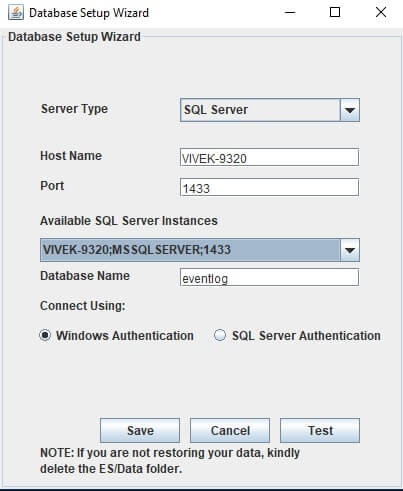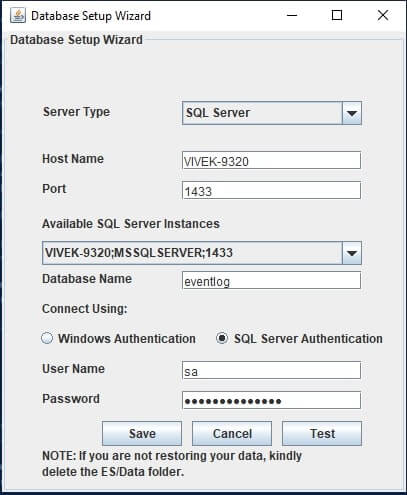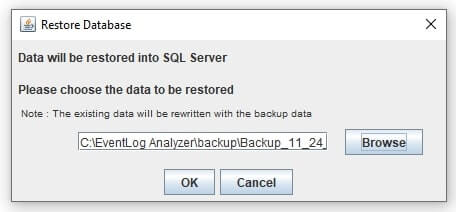Migrate EventLog Analyzer Data from PGSQL to MSSQL Database
Note: Applicable to EventLog Analyzer Build 8050/8051 and the versions above
EventLog Analyzer lets the users to migrate the existing EventLog Analyzer data available in PGSQL database to MSSQL database.
This procedure is applicable only if you are already using the EventLog Analyzer with PGSQL and you want to change the database to MSSQL.
If you want to configure the MSSQL for fresh installation of EventLog Analyzer server, please refer the Configuring MSSQL Database page and follow the procedure given there.
The steps to migrate and run the Eventlog Analyzer server with SQL SERVER as the database is given below:
-
Stop the Eventlog Analyzer Server/Service.
-
Run the command prompt as an administrator. Go to <EventLog Analyzer Home>toolsbackUpDatabase.bat to backup the data available in PGSQL database and wait for backup completion. By default, backup file will be stored under <EventLog Analyzer Home>backup directory with the file name like 'backup_eventlog_<Build_Number>_MM_DD_YYYY_hh_mm.data'.
-
From the installed MS SQL SERVER, copy the files bcp.exe and bcp.rll to <Eventlog Analyzer Home>bin folder.
For Windows Authentication, enter the Domain Name, User Name and Password.
-
Invoke the <Eventlog Analyzer Home>toolschangeDBServer.bat in command prompt, to configure the MS SQLSERVER credentials like ServerName, Port, UserName and Password.
-
Database Setup Wizard pops-up.
-
In the wizard screen, select Server Type as SQL Server. Available SQL Server Instances are listed in a combo box. Enter the Host Name and Port of the SQL Server from the instances.
-
Select the authentication type using the "Connect Using:" options.
-
The options are:
Note: Ensure that both EventLog Analyzer Server and MS SQL Server are in the same domain and logged in with the same Domain Administrator credentials.

For SQL Server Authentication, enter the User Name and Password.

- SQL Server Authentication
-
Click Test button to check whether the credentials are correct. If the test fails, the credentials may be wrong, recheck and enter the correct credentials.
-
Click Save button to save the SQL Server configuration. Note that, it will take few minutes to configure the settings of the SQL Server database.
-
Invoke the <Eventlog Analyzer Home>binrun.bat to start the Eventlog Analyzer server in the command prompt.
-
After the server is started completely, stop the server by terminating the run.bat in the command prompt or invoke the <Eventlog Analyzer Home>binshutdown.bat
-
Invoke the <Eventlog Analyzer Home>toolsrestoreDatabase.bat, browse and select the created backup file. Now click on 'OK' and wait till the database is completely restored.

Note: Executing the restoreDatabase.bat will delete the existing data, if any
-
Start the Eventlog Analyzer Server/Service to work with the MS SQL Server as the database.
Note:
1. You can also change the backup directory. Execute the batch file to backup by passing the absolute path of the directory as argument in the command prompt. Example command execution as follows:
<Eventlog Analyzer Home>tools:>backUpDatabase.bat D:Mysql














